Six sweet home-style Italian recipes from Torta della Nonna by Emiko Davies
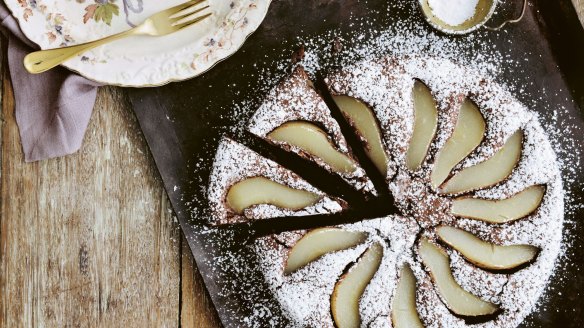
In her new cookbook Torta della Nonna, Emiko Davies writes of her love for old Italian cookbooks.
As a food writer raised between Australia and China, and who is now raising a young family in Florence, these historic recipe collections have helped shape her appreciation of regional Italian cuisine.
"They are as close as you can get to unlocking the recipes of nonna," she writes.
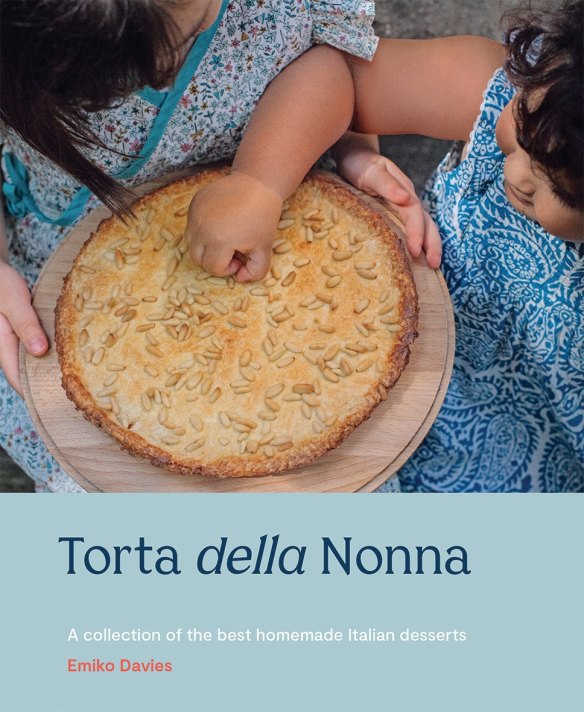
Davies' Tuscan mother-in-law, for example, relied on her mother for recipes, who, in turn, relied on her copy of Pellegrino Artusi's 1891 cookbook Science in the Kitchen and the Art of Eating Well, which was often given to Italian brides to guide them in the kitchen.
Many of the recipes in Davies' new cookbook have their beginnings in Artusi's nearly 800-page tome and other classic volumes, and are drawn from Davies' three previous titles Florentine, Acquacotta and Tortellini at Midnight, along with a handful of new inclusions.
Here are six recipes you'll likely find on nonna's table, in a homely trattoria or in one of the many pastry shops across Florence.
Torta di pera e cioccolato (Pear and chocolate cake)
This is a rich, elegant dessert inspired by one from a favourite Florentine pastry shop. Sometimes you can find this cake encased in a shortcrust pastry too, but I love this on its own, particularly when it has a dense melt-in-the-mouth texture like this one. The chocolate part of this cake is modelled on one of my own favourites: a flourless chocolate cake of Elizabeth David's.
INGREDIENTS
- 50g sugar
- 2 pears, peeled, cored and cut into eighths lengthways
- 150g dark chocolate
- 90g unsalted butter, cubed
- 90g caster sugar
- 90g almond meal
- 3 eggs, separated
- 1 tsp unsweetened cocoa powder, for dusting
- icing sugar, for dusting (optional)
METHOD
- Combine the sugar with 500ml (2 cups) water in a saucepan and set over a medium heat. Add the pear and poach for 10-15 minutes, or until tender but not too soft (a knife should easily penetrate the flesh without any resistance). Drain and let the pear pieces cool.
- Melt the chocolate over a bain-marie. When melted, remove from the heat, add the butter and stir until the butter has melted. Add the sugar and almond meal, stirring to combine. When the mixture is cool, add the egg yolks.
- Preheat the oven to 160C fan-forced (180C conventional). Grease a 22-24cm round springform cake tin and dust with the cocoa powder.
- In a separate bowl, whisk the egg whites to firm peaks, then fold them into the chocolate batter. Pour the chocolate mixture into the tin. Arrange the pear pieces on the top of the batter, pushing them slightly in. Bake for 40 minutes, or until a skewer inserted into the middle of the cake comes out clean.
- When cool, remove the cake from the tin and, just before serving, dust liberally with icing sugar, if desired. Serve in modest slices – this is rather rich.
Serves: 8
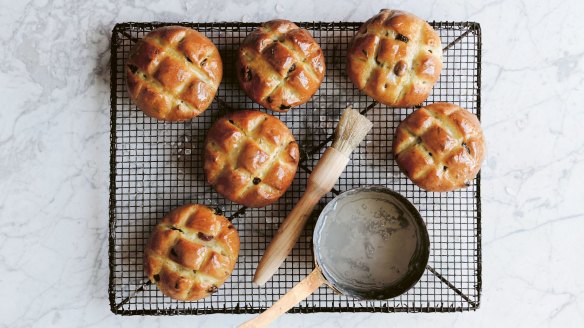
Pandiramerino (Rosemary and sultana buns)
Shiny and delightfully sticky with decorative split, crisscrossed tops, pandiramerino – which means "rosemary bread" (ramerino is the charming Tuscan word for rosmarino or rosemary) – are fragrant with fresh rosemary and studded with sweet sultanas (golden raisins). Traditionally these rustic buns were made for giovedì santo, the Thursday before Easter, and were without sultanas, hence their name. Now you find them year round in bakeries all over Florence.
INGREDIENTS
- 20g fresh yeast, or 7g (2 tsp) active dry yeast
- 1 tbsp sugar
- 180ml (¾ cup) lukewarm water
- 300g (2 cups) plain flour, sifted
- 70g sultanas
- 2 rosemary sprigs, chopped (about 1 tablespoon)
- 60ml (¼ cup) extra-virgin olive oil, plus extra for brushing
- pinch of salt
- 55g (¼ cup) sugar
METHOD
- Combine the yeast, sugar and water in a mixing bowl and let it sit for 10 minutes until dissolved. Pour over the sifted flour and combine to make a firm ball of dough. Place the dough in a lightly greased bowl, cover with plastic wrap or a tea towel and let it rise in a warm place away from draughts for 1 hour.
- Meanwhile, put the sultanas, rosemary and oil together in a bowl and set aside to infuse until the dough has risen.
- Combine the dough with the sultanas, rosemary, oil and salt. Work the ingredients together by kneading, and divide into eight small balls weighing about 70-80g each. Place the buns on a baking tray lined with baking paper and cover loosely with a tea towel. Allow the buns to rise for a further 30 minutes.
- Preheat the oven to 180C fan-forced (200C conventional).
- Brush the tops with olive oil and slash a tick-tack-toe grid (similar to a hash symbol) over each one with a very sharp knife or razor. Let them rest another 10-15 minutes, then bake in the oven for 20 minutes.
- Meanwhile, prepare a sugar syrup by dissolving the sugar in 2 tablespoons of water in a small saucepan and bringing to the boil. Take off the heat and brush the hot buns with the hot syrup.
- The buns are best eaten the day they are made, but they will keep well for 1-2 days in an airtight container.
Makes: 8 buns
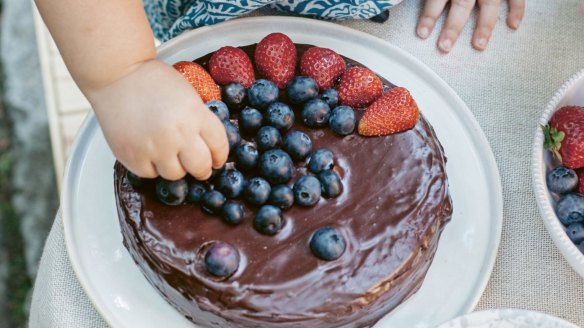
Torta al cioccolato (Chocolate cake)
I love looking through historic Italian cookbooks for interesting, even quirky, recipes, and I was lucky enough to make it the subject of a recipe column when I wrote for Italian newspaper Corriere della Sera. It was there where I first shared my love for this chocolate cake from Ada Boni's 1929 tome, Il Talismano della Felicità, also known simply as The Talisman in its highly abridged English versions.
When I first read the recipe it looked as though a mistake had been made – no eggs, no butter. It intrigued me immediately: a simple cake made with basic pantry staples, which would have been very convenient in Boni's time, between two world wars. It's an intensely deep, dark chocolate cake with a dense crumb, reminiscent of mud cake. Boni intends the cake to be served on its own, but I prefer it dressed up with a topping of chocolate ganache, some whipped cream and fresh berries for contrast, or with a dusting of icing sugar. It's also appealing because it is made with little fuss; you don't even need beaters – a spoon will do.
Being that it doesn't have egg and is easily made without dairy (see notes), this is a handy recipe to have up your sleeve if you're baking for anyone with a dietary restriction – or simply have a bare fridge and a craving for chocolate cake.
INGREDIENTS
- 100g Dutch (unsweetened) cocoa powder, sifted, plus extra for dusting
- 200g (1⅓ cups) plain flour, sifted
- 200g sugar
- 2 tsp baking powder
- pinch of salt
- 1 tsp natural vanilla extract, or 1 vanilla bean, split lengthways and seeds scraped
- 350ml full-cream milk (or alternative, see notes)
METHOD
- Preheat the oven to 160C fan-forced (180C conventional).
- Grease a 20cm round cake tin and dust with sifted cocoa powder. Tap upside down to remove any excess.
- Place the dry ingredients together in a bowl (do make sure the cocoa powder is sifted well to ensure you don't have problems with lumps later). Add the vanilla to the milk, then add this, bit by bit, to the dry ingredients, stirring with a wooden spoon until combined and smooth. If the batter is too stiff, you can add more milk (or even water).
- Pour into the tin and gently smooth the top. Bake for roughly 30 minutes, or until the centre of the cake feels springy to the touch and it smells cooked (see note) – it will be distinctly chocolatey.
- When it has cooled enough to handle, remove from the tin and serve as desired – dusted with icing (sugar or, when completely cooled, covered in ganache (below), perhaps with some berries on top or whipped cream on the side.
- I've experimented with countless versions of this cake, especially making it dairy-free by replacing the milk with alternatives – I've tried it with almond milk and coconut milk (my personal favourite, as it makes a cake so buttery you would never guess it had none); coffee, which brings out the flavour of the chocolate beautifully (I go with a freshly made filtered coffee or an Italian-style moka coffee); and simply water (yes, it works!). I encourage you to experiment if you are interested in making this with other liquids; it is quite surprising how well it works. If you find the batter is slightly stiffer than you would expect, you may need to add a little more liquid.
- If you are using a larger cake tin, it will be slightly thinner and you may want to check the cake a little earlier to ensure you do not overbake this cake.
- A word on the cocoa powder. I use Dutch (unsweetened) cocoa powder, which is the most readily available type in Italy. In this process, the cocoa has been neutralised from its naturally acidic state, which makes it darker in colour, slightly more mellow in flavour, but also more soluble (for drinks such as hot chocolate). Importantly for baking, Dutch cocoa powder must be paired with baking powder rather than bicarbonate of soda, which Ada Boni's original recipe calls for – as in many older recipes, she may have used natural cocoa powder, which is acidic and reacts with the bicarbonate of soda to help the cake rise. You can also use natural cocoa powder here if it is all you have, but do not use bicarbonate of soda in place of the baking powder if you are using Dutch cocoa powder. It's all about the chemistry.
- Prepare the ganache by bringing 75ml thick (double) cream to the boil in a small saucepan. Take off the heat, add 150g finely chopped dark chocolate (70 per cent cocoa) to the cream and stir or whisk until very smooth. If the ganache separates, becoming lumpy or greasy, add a list dash of hot cream (or even hot water) until it is smooth. Pour the warm ganache over the cooled cake and let it cool completely to set before slicing and serving.
Serves: 6-8
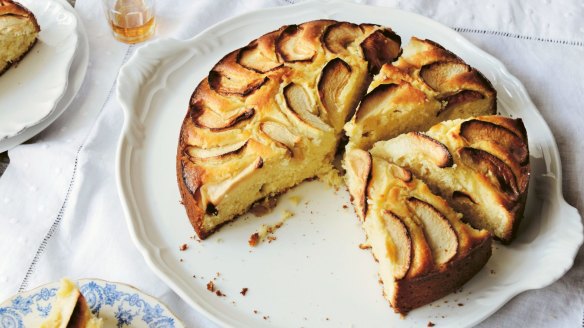
Torta di mele (Apple cake)
This is one of those simple, homely cakes that you imagine everyone's nonna knows how to make and that you will always find, reassuringly, in bakeries, bar and pastry shops all over Tuscany. It's also commonly on trattoria menus for dessert, although many Tuscans eat this for breakfast or a mid-morning snack. It's not overly sweet, as Tuscans don't have much of a sweet tooth, but you could, if you like, brush a little warmed apricot jam over the top once you take it out of the oven for some shine and an extra touch of sweetness. Golden delicious apples are most commonly used in Tuscany for baking, but if you don't have them, use another good cooking apple, such as pink lady or granny smith (though the latter is more tart, so the apricot jam or a dusting of icing sugar would be welcome).
INGREDIENTS
- 2 large golden delicious apples (or other good cooking apple), peeled, cored and sliced 1cm thick
- juice and zest of 1 lemon
- 180g sugar
- 125g unsalted butter, softened
- 3 eggs
- 150ml milk
- 300g (2 cups) plain flour
- 1 tsp baking powder
- pinch of salt
METHOD
- Preheat the oven to 160 fan-forced (180C conventional). Grease and line a 23cm round cake tin.
- Place the apple in a bowl with the lemon juice and 2 tablespoons of the sugar.
- Beat the remaining sugar with the butter until pale and creamy, add the eggs and beat very well until you have a thick, pale mixture. Add the milk and the zest, then fold in the flour, baking powder, salt and half of the apple slices, along with the lemon juice, to combine.
- Pour into the tin and place the remaining apple slices all over the surface. Bake in the oven for 1 hour, or until the top is golden brown and springy to the touch.
Serves: 8
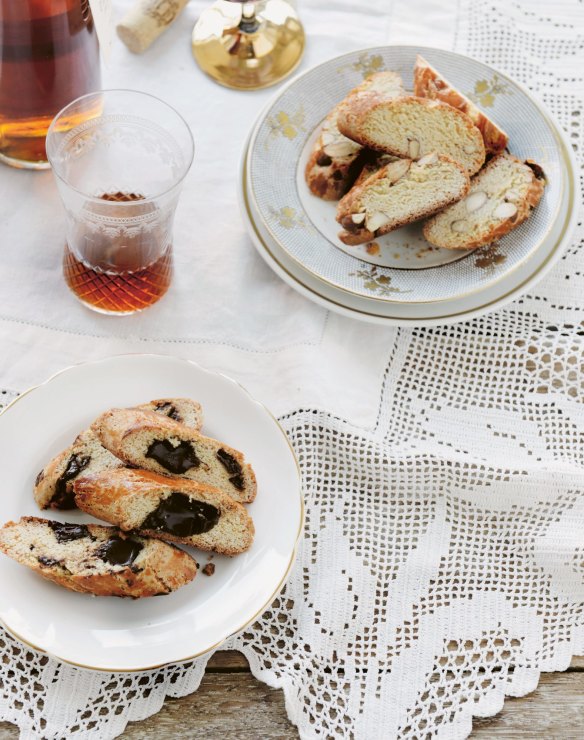
Cantuccini (Almond biscotti)
Tuscan dinners most often end with a plate of almond-studded cantuccini accompanied by the local dessert wine, vin santo (perhaps home-made), poured into small tumblers, with much dunking, drinking, eating and lingering. It's the quintessential element that rounds off any meal, whether it is shared among new or old friends at home or offered by friendly and generous trattoria hosts.
In Tuscany they are known as cantuccini – often named after Florence's neighbour and the city of their invention, Prato – but they are better known as biscotti (the general Italian word for "biscuits") in the English-speaking world. The word biscotti comes from the fact that these biscuits are twice ("bis") cooked ("cotto"), a technique that Pliny the Elder once said would make baked goods keep for centuries. They are first shaped into a sort of flat log, baked, then cut into slices and baked again. The double baking makes them durable, crunchy and perfect for dipping into vin santo or coffee.
INGREDIENTS
- 125g whole almonds, chopped roughly in half
- 350g (2⅓ cups) plain flour
- 200g sugar
- 1 tsp baking powder
- pinch of salt
- 2 whole eggs, plus 1 egg yolk for glazing
- 30ml vin santo
- 1 tbsp honey
METHOD
- Preheat the oven to 160C fan-forced (180C conventional).
- Place the almonds on a baking tray and toast for 10 minutes in the oven, then let them cool.
- Combine the dry ingredients in a large bowl. Make a well in the centre and crack the eggs in (reserve the extra yolk for glazing later). Add the vin santo and honey (warmed, if not runny enough) and beat the wet ingredients with a fork, slowly incorporating the dry ingredients around them until it becomes a dough. Add the almonds and continue mixing with your hands until the dough is well combined.
- Shape the dough into thin logs, about 2cm high, 4cm wide, and slightly flattened. Place on baking trays lined with baking paper, at least 5-8 cm apart.
- Beat the extra egg yolk and brush the tops and sides of the logs with the beaten egg. Bake in the oven at 160 fan-forced (180C conventional) until golden, about 20-25 minutes. Turn the oven down to 130C.
- When just cool enough to handle, slice the logs at a 45-degree angle into 1.5cm slices (use a sharp, heavy kitchen knife that can easily chop through nuts).
- Place the cantuccini on their sides back onto the baking tray, and bake for a further 20 minutes, or until crisp and dry to the touch (but not coloured).
- These biscuits keep well when stored in an airtight container – if they are not eaten all at once.
Variations:
- The recipe for cantuccini has thousands of variations. While the one I use is adapted from my mother-in-law's recipe, it is quite different from the very first 19th-century recipe for biscotti di Prato, which included pine nuts and did not have any raising agents.
- If you do not have vin santo on hand. You could substitute another dessert wine or even rum. Otherwise, simply leave it out.
- You can replace the almonds with an equal amount of large chunks of dark chocolate. Leave the logs to cool completely before slicing and only do the second baking just before serving so you can serve the biscotti warm, with the chocolate just melting.
Makes: about 36 biscotti
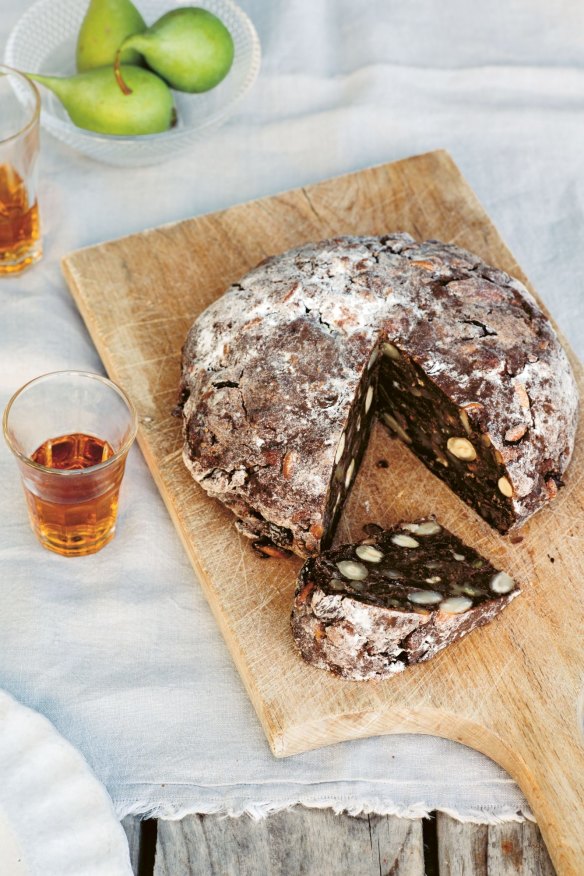
Pagnottella (Fig and chocolate bread)
This wonderful specialty of Porto Santo Stefano on Monte Argentario in Tuscany's south coast is halfway between a fruit cake and something dense and chocolatey, like brownies. It's the kind of thing that you can't find in shops or restaurants or even in cookbooks – it's made at home by those who know the tradition best: nonnas.
I asked a few friends from Porto Santo Stefano if they had a good recipe for pagnottella that I could try and they all came back to me with cherished, handwritten family recipes from their mother or nonna, each of them slightly different. Alessandra's nonna makes this with some grated apple for moisture and keeps the chocolate in huge square inch-sized cubes, resulting in decadent pockets of melted chocolate like molten lava. Orestina makes a version with bread dough and insists on using home-made plum jam (very typical of Argentario, she notes). Valeria's mother, Filomena, cooks dried figs in vermouth for her pagnottella, which otherwise is very similar to Alessandra's nonna's. The one thing most recipes have in common is that the amount of flour called for is quanto basta, or as much as is needed. This means enough to bring the sticky mixture together into a soft dough.
This recipe is inspired mostly by Alessandra's nonna's recipe. It's quite soft, decadent and fruity – not to mention chocolatey. You only need a very thin slice of this, served with some dessert wine. Pagnottella is either made as one large loaf or a few buns, dusted in flour before being baked to set. A variation is to mix all the ingredients into bread dough instead of just flour so that you have a rather hard, dense fruit and nut loaf. All versions keep a very long time and just get better as they age.
INGREDIENTS
- 250g (1⅔ cups) dried figs, roughly chopped
- 500ml (2 cups) white wine
- ¼ apple, peeled, cored and grated
- 100g dark chocolate (70 per cent cocoa), chopped roughly
- zest of 1 orange
- 50g sultanas
- 50g (⅓ cup) pine nuts
- 50g (½ cup) walnut kernels
- 50g (⅓ cup) whole almonds
- 50g whole hazelnuts, peeled
- 2 tbsp unsweetened cocoa powder
- 2 tbsp plum jam
- ¼ tsp ground cinnamon
- ¼ tsp ground nutmeg
- 100g (⅔ cup) plain flour or as needed, plus extra for dusting (see note)
METHOD
- Soak the figs in the wine overnight. Put the soaked figs with all the liquid in a small saucepan and add the grated apple. Bring to a simmer and cook over a low-medium heat until the fruit is soft and the liquid has reduced slightly, about 15 minutes. Blend in a food processor or with a hand-held blender until paste-like. Let it cool.
- Transfer the fig mixture to a large bowl and add the rest of the ingredients except for the flour and combine. Add the flour in a few stages until you have a soft and sticky mixture that has the consistency of bread dough – you may need to add a bit more or a bit less.
- Preheat the oven to 140C fan-forced (160C conventional), line a baking tray with baking paper and dust the top with flour.
- Directly on the baking tray, use floured hands to shape the dough into a round loaf about 20cm wide and flatten it until it's about 5cm tall in the centre. Dust liberally with flour on the top and blow off the excess. Bake in the oven for 25-30 minutes, or until the flour on the tray turns a cappuccino-coloured brown and the bread feels firm.
- This delicious bread lasts ages and ages and ages. It's best to keep it covered/wrapped in plastic wrap or in an airtight container, and stored somewhere cool and dry.
- I find 100g of flour is enough, but all flours are different, and all figs will likely be different too, so use this as a guideline. You might find that your dough can take a lot more.
Variations:
- If you don't have plum jam, you can use another dark jam such as grape or fig, or even substitute completely with honey. I like this even mixture of different nuts, but you could cut it down to one or two kinds. Just choose 200g of any nuts – my friend Orestina likes to use just almonds, for example. You can also use red wine for cooking the figs. Sometimes you'll see this bread in a stick shape – a long loaf rather than a round one.
Serves: 12
This is an edited extract from Torta della Nonna by Emiko Davies, published by Hardie Grant Books, RRP $34.99. Buy now